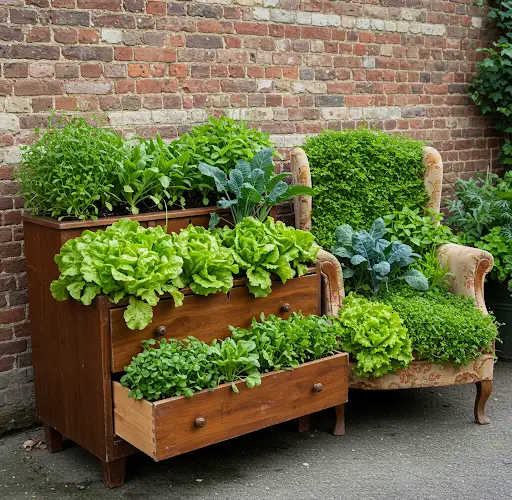Recycling Old Furniture to Grow Green Vegetables and Save Space
As urban living continues to shrink our gardening space, creative solutions are becoming essential for anyone who wants to grow their own vegetables at home. One inspiring and eco-friendly trend gaining popularity is recycling old furniture to grow green vegetables. Whether you’re working with a tiny balcony, a small backyard, or a rooftop, repurposing furniture can turn unused or discarded items into thriving mini-gardens.
From drawers to bookshelves, chairs to cabinets, many types of furniture can be transformed into productive garden containers. Not only does this method save space, but it also promotes sustainability and reduces household waste. Here’s how you can bring new life to old furniture while growing fresh greens right at home.
Why Recycle Old Furniture for Gardening?
Using furniture for gardening offers several unique advantages:
-
Space-efficient: Vertical shelves, tiered drawers, and layered cabinets maximize growing space, especially in small areas.
-
Eco-friendly: Keeps old furniture out of landfills and supports upcycling.
-
Budget-friendly: Eliminates the need to buy pots, beds, or planters.
-
Decorative and functional: Adds a rustic or vintage touch to your garden while being productive.
-
Flexible placement: Furniture gardens can be moved or modified as needed.
Best of all, most leafy vegetables have shallow roots and grow well in compact containers, making them ideal candidates for furniture-based planters.
Best Furniture Items to Reuse for Gardening
Here are some common pieces of old furniture that can be easily converted into garden containers:
-
Wooden drawers – Stack or separate them to grow herbs or leafy greens.
-
Bookshelves – Lay them flat or stand them vertically for tiered planting.
-
Chairs – Remove the seat and place a pot or soil-filled basket in its place.
-
Dressers – Open drawers at varying levels for a cascading garden look.
-
Cabinets – Great for creating mini greenhouses or enclosed planters.
-
Tables – Use tabletops to hold pots or cut holes to insert planters.
Make sure the furniture is sturdy enough to support soil and moisture, or reinforce it if necessary.
How to Turn Old Furniture into Garden Beds
Step 1: Clean and Prepare
-
Remove any old hardware, paint, or finishes that might contain harmful chemicals.
-
Sand rough edges to avoid splinters or injury.
-
If the item is made of untreated wood, consider sealing it with a non-toxic, waterproof sealant to prevent rot.
Step 2: Create Drainage
Plants need well-draining soil to thrive. For this:
-
Drill or poke holes in the bottom of drawers, shelves, or boxes.
-
If drilling isn’t possible, create a drainage layer using gravel or broken clay pots at the bottom.
-
Line the furniture with a plastic sheet, grow bag, or old cloth to hold soil while allowing water to drain.
Step 3: Add Soil
Use a rich, well-draining soil mix suited for leafy vegetables. A simple blend includes:
-
50% garden soil or cocopeat
-
30% compost or organic matter
-
20% sand or perlite for aeration
Fill each container to about 1–2 inches below the rim to prevent overflow when watering.
Step 4: Choose and Plant Your Greens
You can grow a wide variety of leafy vegetables in recycled furniture containers. Some great choices include:
-
Spinach
-
Lettuce
-
Mustard greens
-
Arugula
-
Kale
-
Bok choy
-
Swiss chard
Sow seeds or transplant seedlings based on the depth and width of the furniture. Leafy greens don’t require deep soil, so most drawers and shelves will be adequate.
Caring for Your Furniture Garden
Sunlight:
Place the furniture where it can receive at least 4–6 hours of sunlight daily. Rooftops, balconies, and near windows are ideal.
Watering:
Check soil moisture daily, especially if growing in small or shallow containers. Water gently but thoroughly to keep soil evenly moist.
Feeding:
Feed plants with organic liquid fertilizer (like compost tea or seaweed solution) every 10–14 days to support leafy growth.
Pest Control:
Inspect plants regularly for pests like aphids or caterpillars. Use neem oil or a mild soap spray to keep pests in check.
Creative Ideas to Maximize Space
-
Vertical dresser garden: Open drawers at different levels and plant in each one for a tiered effect.
-
Chair planter: Remove the seat of an old chair and insert a grow bag or pot for a charming garden chair.
-
Bookshelf wall garden: Lay a bookshelf on its back and plant in each compartment, or stand it up against a wall and add pots to each shelf.
Add wheels to the base of large items like cabinets or dressers for mobility and easier repositioning.
Conclusion
Recycling old furniture into garden beds is a creative and practical way to grow your own green vegetables while saving space and reducing waste. It’s a project that not only benefits your household by providing fresh, homegrown food, but also supports a more sustainable lifestyle.
Whether you repurpose a forgotten dresser or transform a bookshelf into a vertical farm, this approach proves that you don’t need a big yard to have a productive garden. All it takes is a bit of imagination, a piece of old furniture, and a love for growing your own greens.



